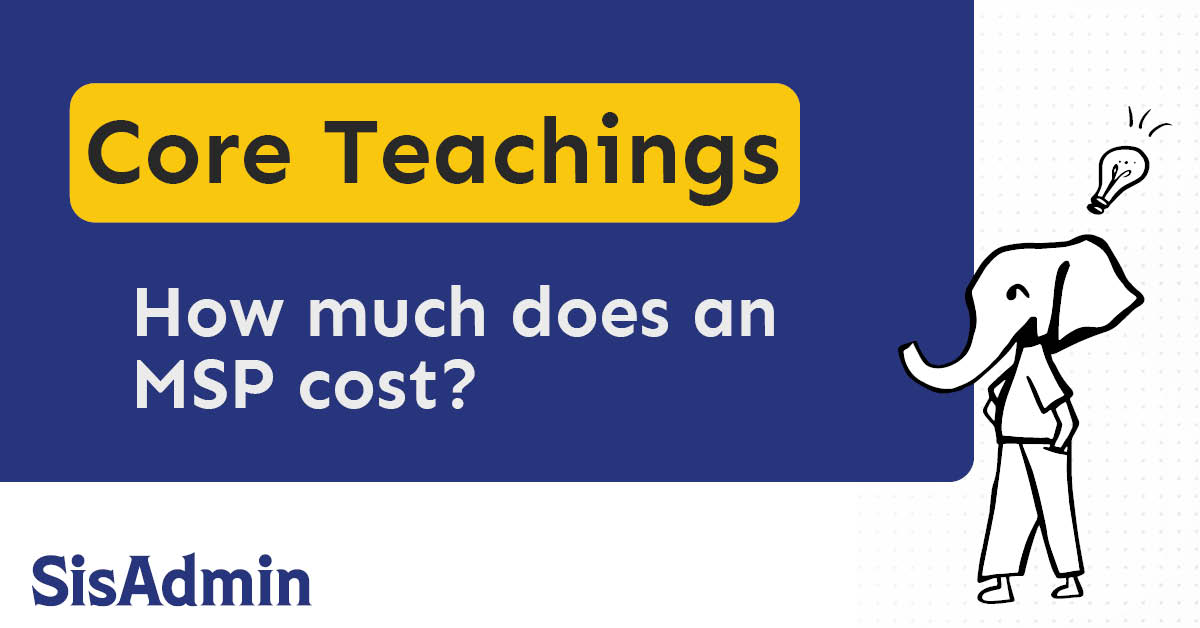How Much Does an MSP Cost and How Are Plans Priced?
We have some very helpful articles about how MSP plans are constructed and some of the factors that influence price. We strongly encouraged reading the following articles before reading this one:
- What is an MSP and what services do they provide?
- How do MSPs Differ and Why are the Differences Important?
- Cheeseburgers and Tech: What makes IT Support So Expensive?
Once you’ve familiarized yourself with some of the basics, we can now take a deeper dive into cost and pricing.
MSP packaging and pricing is so complex and variable, that entire books have been written on the subject. It’s arguably the most difficult and important business decision an MSP makes. It has taken many an MSP owner down a bottomless rabbit hole, where they have spent hundreds, if not thousands, of hours.
But why is it so difficult to determine the right cost? The problem is that there are millions and millions of different ways and combinations to build a service plan, and an equal number of ways to come up with the pricing.
A peek behind the MSP industry curtain – Getting the inside info
I’m going to give you a peak behind the MSP industry curtain throughout this article. The first inside piece of information I will reveal to you are the two components that make up the “holy grail” of the outsourced IT support industry: Monthly Recurring Revenue (MRR) and Agreement Gross Margin (AGM).
In our industry, MRR is king. This term refers to the amount our clients pay each month, ideally in advance, for our plan(s). A plan typically consists of a package of tools and services. Profitable MRR is the most valuable revenue stream in the MSP industry because it is the lifeblood of the organization. For an MSP, their service plan(s) are their primary source of MRR.
I used a key word in the sentence above… profitable. Another somewhat dirty little secret in the MSP industry is that it can be challenging to be profitable and, in fact, a majority of MSPs do not operate at a healthy profit margin. The main reason for this is most MSPs don’t have a good understanding of their costs (Cost of Goods Sold or COGS). They often have no idea how to price their services appropriately and to find an appealing way to make those services profitable.
If you were in the business of selling widgets, and you didn’t know how much those widgets cost to design, manufacture, market and sell, would you be confident in your ability to set the retail price? Would you know if they’re selling at a profit? I didn’t think so. Yet, this is how a majority of MSPs continue to operate. This is important to understand because if an MSP doesn’t understand it’s costs and prices their plans too low, it will not have the resources to deliver upon its commitments. To put it crudely, the MSP is writing checks its ass can’t cash.
The MSP is writing checks its ass can’t cash
Why the maturity level of an MSP is important
An important factor in the price you pay to an MSP is the maturity level of the organization. Each MSP goes through a maturation process; from an infant to a toddler, to an adolescent then eventually a functional adult (that’s the goal anyway). This means that each MSP you evaluate will be at one of these maturity levels. As a consumer, it’s your job to determine which. See our “How do I decide which MSP is right for Me” article for some tips on how to evaluate maturity level.
Maturity level is really important, because not only does it influence price, it also influences the quality of service you will receive. Another word for this is “value”. You get what you pay for and my advice is to be highly skeptical of low-cost providers. They’re cheap for a reason.
Want to hear a real company’s experience with a low-cost provider? Check out our Case Study on Leaving Break-Fix IT.
Be highly skeptical of low-cost providers. They’re cheap for a reason.
Why “value” is an important consideration
In my Cheeseburgers article, I describe how some of the main ingredients in MSP service plans are consistent across the industry, but I also advise that the quality of said ingredients is highly variable. I caution you from assuming that the MSP industry is heavily commoditized because of this. It is not. Allow me to explain.
Let’s take a t-shirt as an example. You can march down to Walmart and buy a plain t-shirt for $2.98. The t-shirt is made of cotton, comes in difference sizes, has two holes for your arms and one for your head, and generally covers your body in the same way as any other t-shirt. Now let’s look at a luxury brand t-shirt. You’re still buying a t-shirt, made of cotton, only with the cache of a famous brand and logo, and you’ll need to pay $850 for that Gucci t-shirt.
The primary difference between the two shirts is the “value” each one has. MSPs are no different. Value is defined as “the regard that something is held to deserve; the importance, worth, or usefulness of something.” Value is not determined by the products being similar in type or use. Value is in the eye of the beholder and is assessed by the purchasers, and changes over time. It has nothing to do with the cost to make the item. The value of goods and services has everything to do with the how much the good or service is worth to you.
The value of goods and services has everything to do with the how much the good or service is worth to you.
How MSPs package and price
Understanding the concept of value is intrinsically important to understanding how MSPs package and price their services. Remember I said above, there are literally a million choices that can be made when an MSP creates its service offerings. The top considerations an MSP must consider when creating their services offerings are:
- What should I include?
- What should I exclude?
- How many plans should I have?
- What should I call my plans?
- How do I structure my pricing?
Although you probably won’t be creating any MSP plans any time soon, let’s delve into these questions so you can understand the ramifications of these choices at a consumer level.
What does the MSP include in the plan?
The short answer is “whatever they choose” and there is no perfect answer in the MSP industry. The unfortunate truth is that it’s up to you, as the consumer, to be aware of what you need and don’t need, and to make the best choice based upon the best information you can obtain.
What does the MSP exclude in the plan?
This is a simple one but MSPs still make it complicated. Everything that is not included in the plan should be automatically excluded. Unfortunately, a lot of MSP agreements are not constructed this way and instead attempt to list and describe exclusions. This is purely a risk management move by the MSP. If there is a list of exclusions, carefully evaluate them so you know what you’ll be dinged for and why.
How many plans does the MSP have?
This question differs among MSP’s due to maturity level. Smaller, more immature MSPs will typically have a three-tier option. Sometimes they offer more than three. The three plans are usually broken down as Good, Better and Best as follows:
- Good: Includes all the non-negotiable things the MSP decides each customer needs.
- Better: A bit more expensive than “Good” but includes some extra value that entices customers. Most of the MSPs clients will fall into this plan.
- Best: The MSP’s premium offering. A small percentage of the MSP’s clients will select this plan.
Some drawbacks of Good, Better and Best are influenced by human nature. No one really enjoys giving sub-standard services to clients so if the MSP has a conscience, it’s difficult to truly prioritize categories of clients over each other. Do the “Best” clients really get the best work and results the MSP offers? MSP environments are hectic, and in time of need “Good” and “Better” customers don’t want to be told they’re being de-prioritized so the MSP can take care of the “Best” customers. Human nature dictates that prioritizing customers based upon their plan status is very challenging in every day practice.
This is why most mature MSPs end up with a single plan. Getting to a single plan requires maturity across all areas of an MSP including sales and operations. Single plan MSPs usually offer high, tangible value. The value isn’t as much about the “ingredients” it includes, although it’s still important. It’s more about the tangible outcomes the MSP delivers to your business.
What does the MSP call its plans?
This is where MSPs get creative with Good, Better and Best. You’ll run into names like gold, silver, and bronze. Basic, standard, and premium is another common one. Regardless, you’re evaluating the same type of packaging strategy.
How does the MSP structure its pricing?
As I mentioned before, this is another area where there are almost limitless choices because different prices and terms can be applied throughout the plan and service agreement. You may get charged for onsite work, travel, priority response time, after-hours support, or different levels of engineers. You get the picture. Carefully evaluate the plan and the agreement to make sure you are as clear as possible about pricing and how you will be charged.
You will encounter many different general pricing strategies such as per-user, per device, core infrastructure charges, multi-site fees, etc. Again, this is variable among MSPs but the generally accepted industry standard is per-user pricing.
One last tip
My one last piece of advice is to evaluate the contract terms and be comfortable with what you are signing (obviously!). A hotly debated topic in the MSP industry is whether clients should be locked into contracts. The upside for the MSP is that they want you to be a “sticky” customer. The downside for the MSP is that they don’t want to be locked into a bad relationship. Both are right and wrong at the same time. So long as you are happy with the pros and cons of the contract terms, that’s really all that matters.
Evaluate the contract terms and be comfortable with what you are signing.



